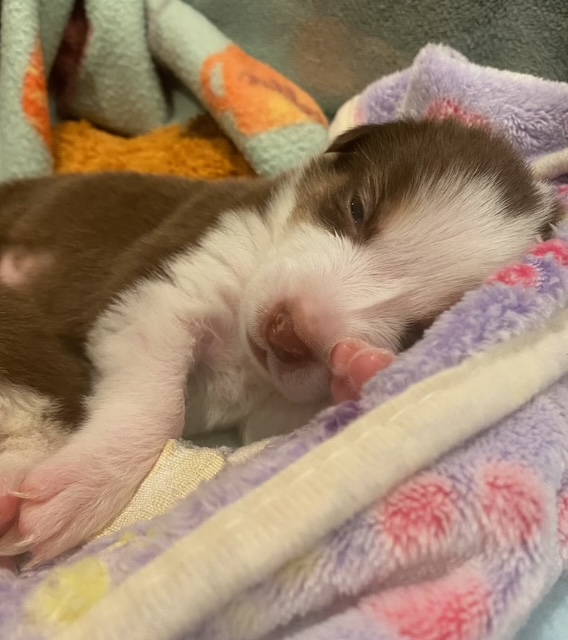It was the middle of the night when Loretta’s breathing changed. One hour earlier, she had been eating normally—tiny, eager, and full of life. But now, her body had gone limp. Her gums were pale, her body cold, and her suckle reflex completely gone. She was barely hanging on.
When you’ve raised hundreds of orphaned neonates, you learn to recognize that look in a puppy’s eyes—that quiet, eerie stillness. Loretta was crashing. And we had minutes to act.
What Loretta was experiencing is known as Fading Puppy Syndrome (FPS)—a heartbreaking but all-too-common condition in neonatal puppies. In this case study, we’ll walk you through Loretta’s story and the exact steps we took to save her life. Our hope is that sharing this experience will help others respond quickly and compassionately to a fading puppy—and possibly save a life.
Understanding the Silent Crisis: What Is Fading Puppy Syndrome?
Fading Puppy Syndrome, or FPS, is one of the most emotionally devastating challenges we face in neonatal rescue. It’s heartbreaking, often sudden, and frequently inexplicable. The truth is—we still don’t fully understand why it happens.
FPS can be caused by a wide variety of factors, including infections, environmental stressors, maternal neglect, failure of passive immunity, or even birth defects. Sometimes, everything appears perfect—temperature controlled, fed on time, no signs of illness—and a puppy will still begin to fade. It’s what makes this syndrome so difficult and painful.
FPS isn’t a single disease—it’s a silent cascade. A chain reaction of failure in the body’s most vital systems. It often begins subtly and progresses quickly. Without immediate intervention, a fading puppy can be lost in a matter of hours.
The 4 H’s of Fading Puppy Syndrome
Canine neonatologists often refer to the 4 H’s when diagnosing and treating FPS:
- Hypothermia (low body temperature)
- Hypoxia (low oxygen)
- Hypoglycemia (low blood sugar)
- (De)Hydration (fluid imbalance)
These four conditions are deeply connected—and once a puppy begins fading, all four must be addressed urgently and in the correct order. Treating them out of order can mean your efforts don’t work—or worse, backfire.
Recognizing the Signs
Loretta’s symptoms were textbook:
- Cold to the touch, even in her incubator
- Lethargic, limp, and unresponsive
- Pale gums and dry nose
- Refusing to suckle her bottle
These are the moments when your heart races, your hands shake, and you know you’re in a race against time. Had we waited even an hour longer, Loretta likely would not have survived. Every minute matters.
Every Second Counts: Loretta’s Emergency Rescue Protocol
When a puppy is fading, speed and order matter. Treating the wrong symptom first can make everything else ineffective. Here’s how we tackled each of Loretta’s “H’s”—in the exact order we recommend for any rescuer, foster, or veterinary team.
1. Hypothermia: Warm the Puppy—Now
Although Loretta was already inside a temperature-controlled incubator, her body was too weak to retain heat. That’s the tricky thing about hypothermia in neonates—even in a warm space, their core temperature can plummet if their bodies aren’t strong enough to hold it.
We immediately placed Loretta on a heated rice sock, wrapped gently in a towel, and placed her back in the incubator. This provided direct warmth to her core and helped raise her internal temperature safely. We monitored her with a rectal thermometer every 10 minutes.
Note: Never attempt to feed or medicate a cold puppy. Warming is always the first and most urgent step because when a puppy’s body temperature drops, their digestive system slows down significantly. A cold puppy cannot properly absorb nutrients or glucose, and attempting to feed them can lead to undigested formula fermenting in the stomach or even aspiration if the puppy is too weak to swallow. Their body must first be warmed to at least 95°F to safely begin any feeding or medication.
2. Hypoglycemia: Boost Blood Sugar Gently and Consistently
Once Loretta was warm, we began addressing her blood sugar levels. Her tiny body was depleted of energy and could no longer function.
We gave her a few drops of oral dextrose solution every 15 minutes using a small syringe. This helped raise her blood sugar gradually without shocking her system. Overloading her digestive tract would have risked aspiration or gastrointestinal shutdown.
We continued glucose drops for an hour until she began to show minimal responsiveness—twitching, a faint suckle motion. It was a small sign of hope.
3. Hypoxia: Provide Supplemental Oxygen
Loretta’s breathing was shallow, and her gums had a grayish tint—signs of inadequate oxygen. We turned on our oxygen concentrator and delivered 1 liter per minute into her incubator using tubing positioned near her nose.
This gentle flow of oxygen helped stabilize her circulation, giving her cells and organs the oxygen they needed to begin recovery.
Pro Tip: Even a simple oxygen setup can make a lifesaving difference. You don’t need an expensive oxygen cage—just controlled, consistent airflow.
4. (De)Hydration: Subcutaneous Fluids to Restore Balance
Loretta’s hydration status was poor. Her gums were tacky, and her skin stayed tented when pinched. This meant her cells weren’t receiving the fluids they needed to function.
We administered subcutaneous fluids (warm, sterile Lactated Ringer’s solution) between her shoulder blades. This rehydrated her tissues slowly and safely, improving her circulation and supporting kidney function.
She remained on heat and oxygen during the process and was closely monitored for adverse reactions.
The Turning Point: When Love Did What Medicine Couldn’t
Despite every effort, Loretta began to slip further. Her temperature wouldn’t rise. Her breathing stayed shallow. She wasn’t responding to the dextrose, the fluids, the oxygen, or even the heat. Her body was still. Her spirit quiet. And in that moment, when nothing else was working, we did the only thing left to do: we held her.
I tucked Loretta inside my shirt, pressed her tiny body against my chest, and whispered to her that she wasn’t alone. That if she needed to go, I would be with her. That she was safe. Loved. Not forgotten.
But Loretta didn’t leave.
She stayed. And slowly—so very slowly—she started to respond. Her breathing deepened. Her gums turned slightly pink. Her body relaxed. It wasn’t a miracle. It was connection. Contact. Comfort.
I gently placed her back in the incubator to rest. And when I checked on her next, she lifted her head. She sought the bottle. She was hungry.
That moment—the first feed after fading—is unforgettable. It’s the signal that the crisis has passed. That the little life in your hands has chosen to fight. Loretta suckled on her own, swallowed every drop, and looked up with eyes that held a spark. Her temperature was normal. Her gums were pink. Her heartbeat was strong.
Loretta had pulled through.
From Crisis to Comeback
Once Loretta was stabilized, we moved from rescue mode into recovery mode—focusing on strengthening her immune system and supporting her healing long-term. This includes both science-backed supplements and natural, holistic remedies tailored specifically for orphaned neonates.
Thymus Gland Support: Why It Matters in Neonates
The thymus gland is essential in building a newborn puppy’s immune system. It’s responsible for producing T-cells, which fight infection and regulate immune responses. But in neonates, especially orphans without maternal antibodies, the thymus is underdeveloped and easily compromised.
To help Loretta, we administered a custom-formulated supplement we call Magic Dirt. This holistic blend includes desiccated beef thymus, adrenal, and other bovine organs, along with goat’s milk colostrum, probiotics, and other nutrient-rich elements designed to support both immune and gastrointestinal health. Magic Dirt mimics the protective biofactors found in a mother’s milk and organ meats, helping to “educate” the immune system and promote resilience in fragile newborns.
Other Natural Boosters and Remedies
In addition to Magic Dirt, Loretta also received:
- Electrolyte solution to maintain hydration between formula feeds
- Probiotic blends to repopulate gut flora disrupted by stress and early life instability
- Homeopathic remedies, including gentle immune modulators and energy-balancing tinctures to reduce inflammation and support healing
Each supplement was chosen specifically for its safety in neonatal puppies and given in carefully measured doses based on Loretta’s weight and energy level. These gentle, layered supports helped rebuild her strength and gave her system the tools it needed to keep recovering without relapse.
Healing Takes Time
Constant Observation
The first 48 hours after a crash are the most critical. Puppies who fade once are at high risk of fading again. We:
- Checked her temperature every 2 hours
- Continued dextrose every 3–4 hours
- Maintained oxygen flow
- Limited handling and stimulation
We documented every change—heart rate, feeding behavior, elimination—to detect any signs of relapse.
Small, Frequent Feeds
As Loretta regained strength, her suckle reflex returned. We resumed feeding, but cautiously—every 60–90 minutes, offering only small volumes to avoid overwhelming her digestive system.
Her appetite slowly returned, and she began gaining weight. The first full bottle she finished on her own? We cried. That’s when we knew she had turned a corner.
Lessons from Loretta: How You Can Save a Life Too
Loretta’s survival wasn’t a miracle. It was science, urgency, and compassion in motion.
Fading Puppy Syndrome is terrifying—but it doesn’t have to be fatal. If you recognize the symptoms early and treat them in the right order, puppies can and do survive. Loretta did. And now she’s a thriving, wiggly little soul with a spark in her eye and strength in her step.
If you ever find yourself with a fading puppy, remember Loretta’s story. Start with warmth. Address blood sugar. Offer oxygen. Rehydrate. Then, support their fragile little bodies with every tool and resource you have.
Because when it comes to these fragile newborns, every second counts—and every action matters.
Want to learn more or support our mission? Visit www.blazintrailsbottlebabies.org/resources to access emergency care guides, supply checklists, and ways to help.


